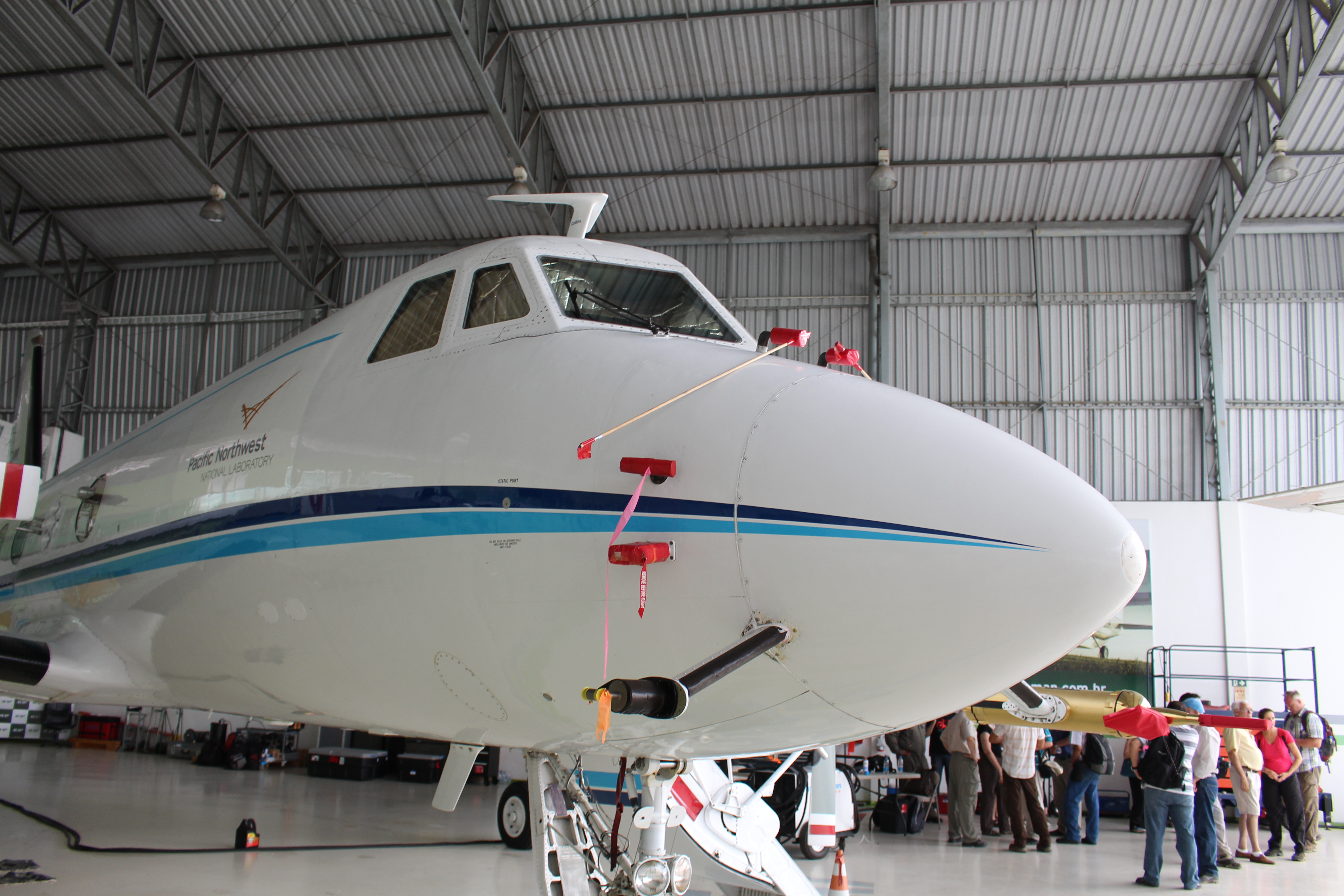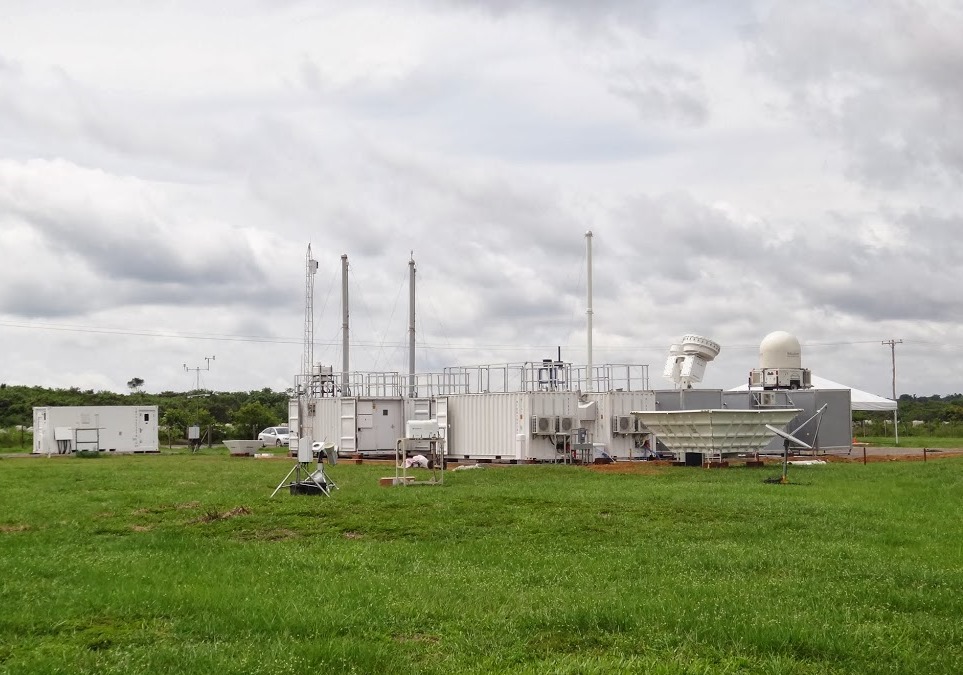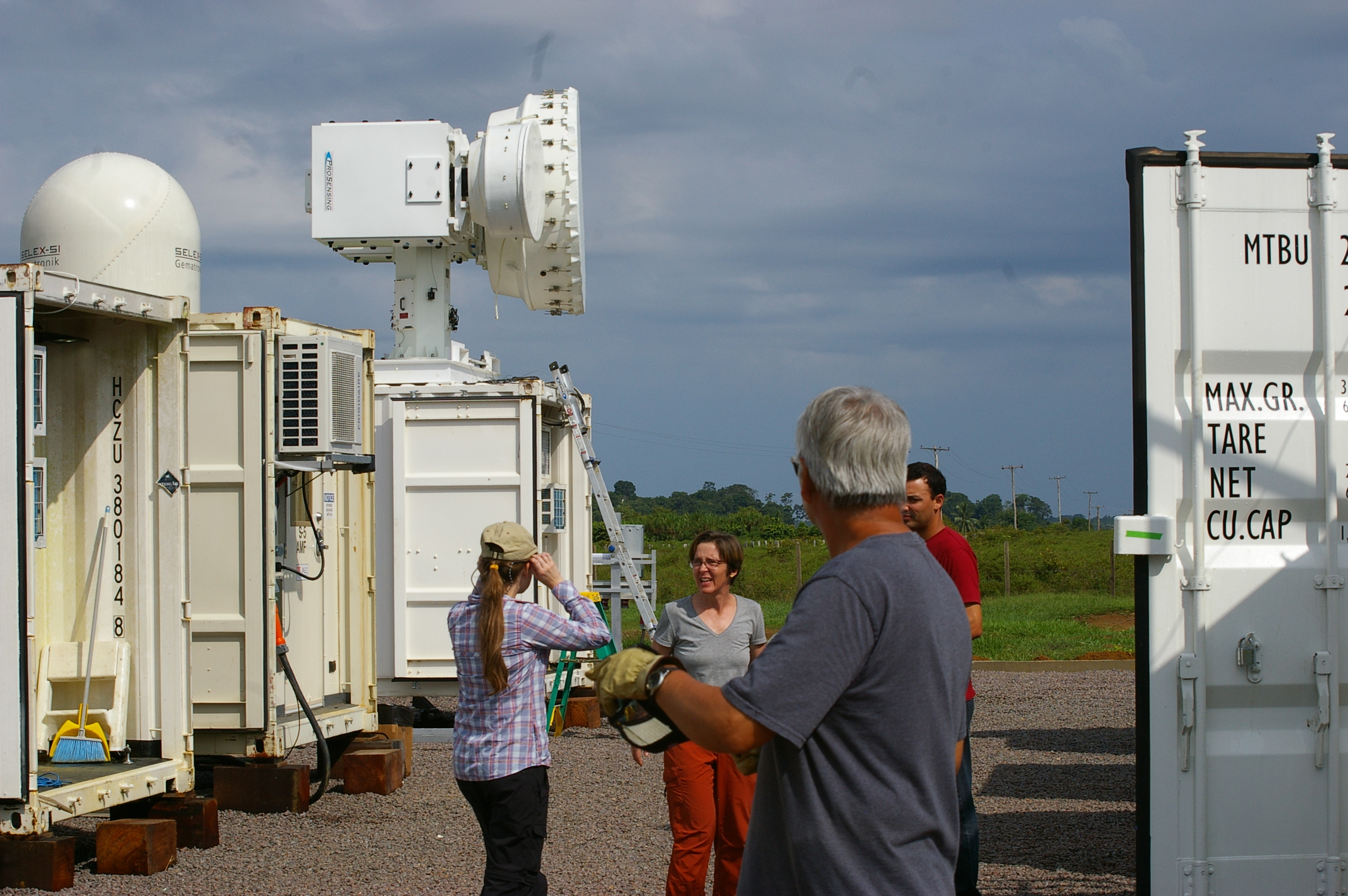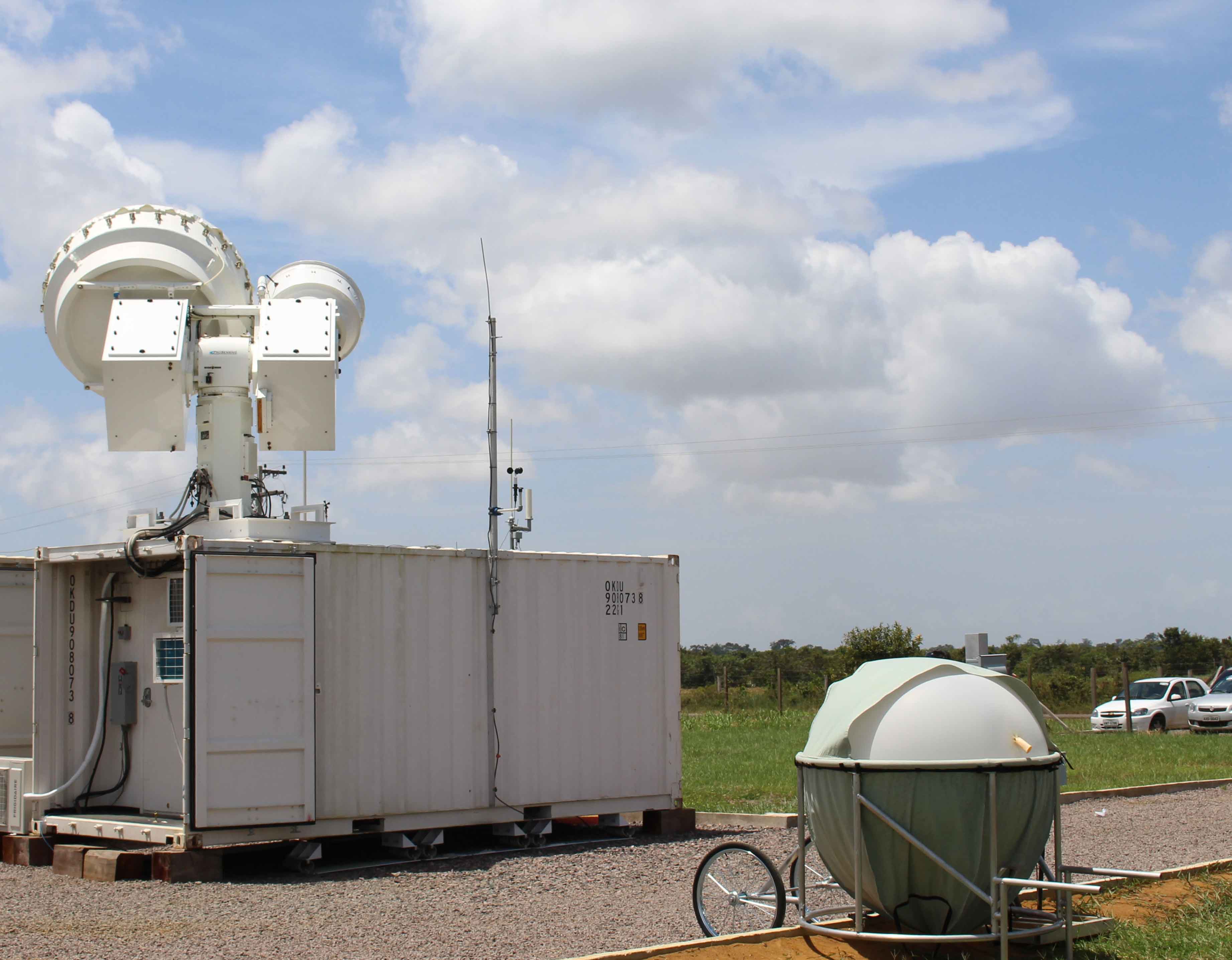Partnerships Put the “Go” in the GoAmazon 2014/15 Campaign
Published: 24 August 2015
Support of Brazilian Partners is Indispensable in Making the Campaign Viable

Scientists are already starting to analyze preliminary data collected in extensive aerial and land-based observations during two intensive operational periods in 2014. Nearly 30 related campaigns also gathered data to be pooled for scientific use.
Ground-based instruments provided by the Atmospheric Radiation Measurement (ARM) Climate Research Facility will continue recording data downwind of Manaus (population 2.5 million) at the Manacapuru site through 2015. Both the ARM Aerial Facility’s G-1 aircraft and the ARM Mobile Facility (AMF) have been key components of the Green Ocean Amazon, or GoAmazon 2014/15, field campaign’s efforts to understand the intricacies of the natural state of the Amazon rain forest.
Largest ARM Deployment Ever
Kim Nitschke, ARM Facilities Manager at Los Alamos National Laboratory, said the GoAmazon campaign is the largest international deployment ever conducted by the U.S. Department of Energy (DOE)-funded ARM Facility. Both DOE and Brazil contributed instruments, along with about 20 other institutions, requiring about 15 modified sea containers to house everything at Manacapuru. Additional instrumentation provided by university investigators contributed to the overall amount of data collected. Some duplication is good, as multiple data sets help to validate each other and improve accuracy.

U.S. and Brazilian scientists who participated in GoAmazon attended a conference at Harvard University in May 2015, contributing some 37 presentations and 27 posters that highlighted early analyses of data already gathered. Some preliminary insights from the conference provided glimmers of new scientific understanding, according to Scot Martin, Harvard professor of environmental chemistry and lead scientist for the study.
“This is a joint project where we are thinking about scientific questions related to clouds and aerosols,” Martin explained. “The Brazilian partners are fully invested and contributed many instruments to the sites. We have shared scientific goals and, as we start the analysis portion of the study, we have data sets from both groups to address our questions. The campaign is in the Brazilians’ back yard and they have helped to make sure we’re doing everything as efficiently as possible.”
A Data Set Unlike Any Other
“Pooling equipment has expanded the range of measurements and the scale of the study,” Martin continued. “The pooled data allows researchers to address different scientific questions using all the data sets. We’ve had a lot of great results out of the campaigns. Right now, as a group, we’re analyzing preliminary data. No other data set like this one has been collected before.”
Observations announced at Harvard regarding aerosol particles, cloud droplets, and lightning strikes inside the pollution plume emanating from Manaus were “important,” though additional verification is needed, according to Martin.
“The data about lightning really are new, but it needs to be developed more,” he added. “If you ask scientists what we would be most interested in—or blown away by—it would be that, according to observations, lightning strikes were 100 times more likely in the Manaus pollution plume than outside of it. That’s an impressive thing for field researchers to say. Downwind of a big city, we expect it, but these data actually quantifies it.”
Individual researchers have specific questions about their own areas of interest and GoAmazon’s comprehensive data sets will provide a variety of insights, contributing to a clearer and more detailed picture of the Amazon Basin climate.
University of São Paulo Professor Rachel Albrecht’s research focused on how aerosols, clouds, and precipitation interact in deep convection to create lightning in the Amazon basin. “Clouds that develop into thunderstorms tend to form in places where there are more aerosols,” she explained. Adding that, “there is not a linear relationship between lightning and rainfall.”
During the wet season (November to May) there is little lightning compared to September and October, the latter end of the dry season, she explained.
Rainfall and Lightning: A Classical Mismatch
“It’s a classical mismatch,” Albrecht said. “You need more than just rainfall to make lightning. You need the strong convection and the right amount and size of ice particles. The cloud invigoration theory works well for the Amazon Basin during the wet season. When we have high numbers of aerosols, we have smaller droplets that won’t get big enough to fall. With strong convection they rise to the ice phase and we get electrical collisions between ice crystals that form lightning. If we have more aerosols, we grow more thunderstorms as we transition to the wet season. In September, however, the local thermodynamics are already great for deep convection and thunderstorm development, but the actual effects of aerosols on clouds are still uncertain. For example, extremely polluted clouds have many ice particles, but they are so small they don’t transfer much electrical charge during collisions—that reduces lightning activity.”

“Ozone is an oxidizer. It is very reactive with monoterpenes, producing particles or aerosols that become seeds for cloud formation,” Fuentes pointed out. “This is one of the mechanisms known to make up atmospheric particulates in the tropics. In remote areas of a rain forest, air is super clean, meaning that it lacks particulates that form clouds. For that reason, you don’t see many rain-producing clouds forming above remote areas of the rain forest. Clouds need particles to form.”
Professor Courtney Schumacher of Texas A&M University collaborated with Fuentes, studying the diurnal convection cycle in the Amazon Basin. “It’s much more complicated than ‘the sun comes up and it rains,'” she said, noting that even the breeze coming off the Amazon River creates its own circulation, impacting day-to-day storm formation.
Studying the Contribution of River Breezes
“River breezes are fascinating. We are learning to understand them better,” Schumacher explained, giving another nod to the value of partnerships. “The more statistics and direct observations we have, the stronger our statements and confidence can be about what is happening. We can say with more certainty what it is that affects the diurnal cycle.”
Clouds and convection are also an important focus for Jiwen Fan, a Pacific Northwest National Laboratory (PNNL) scientist. She said the partnership with Brazil provides valuable data on cloud properties gathered with X-band and S-band radar, helping her understand how convection is initiated and how clouds create rainfall.
“Another important body of information is plume and emission data,” Fan explained. “We have partners from Brazil who provide emission data that are helpful for research on how aerosols affect convection, while other partners from Brazil provided us surface and soil-moisture data unique for the Amazon Basin. We use some of these data to drive our simulation models and some to compare against our simulations. We are still working to improve these simulations so that we can better understand processes affecting convection in the Amazon.”

Toward Better Climate Models
“Everybody’s contribution is valuable,” Fast elaborated. “The project is accumulating so much data that no one person could analyze it and understand everything that has been uncovered. It’s a level of complexity we don’t have in our models and we hope to improve how they represent aerosols and clouds. Right now, the models we have are too simple.”
Researcher Luiz Machado of Brazil’s National Institute for Space Research said GoAmazon data will help confirm hypotheses about the importance of convection in transporting pollution both upward and downward. “We are learning the effects of pollution as it interacts with clouds and precipitation,” he asserted. “We need to learn a lot more to calculate all physical mechanisms influencing the energy and water budget in the Amazon. As we learn to model how the system works, short- and mid-range weather forecasting will improve for the Amazon Basin. Since the basin impacts global climate, weather forecasts will also improve in the middle latitudes—especially the mid-range forecasts—as we develop better climate simulations.”
# # #
The ARM Climate Research Facility is a national scientific user facility funded through the U.S. Department of Energy’s Office of Science. The ARM Facility is operated by nine Department of Energy national laboratories, including Los Alamos National Laboratory, which manages two of ARM’s mobile facilities.
The ARM Climate Research Facility is a DOE Office of Science user facility. The ARM Facility is operated by nine DOE national laboratories, including .
Keep up with the Atmospheric Observer
Updates on ARM news, events, and opportunities delivered to your inbox
ARM User Profile
ARM welcomes users from all institutions and nations. A free ARM user account is needed to access ARM data.


















